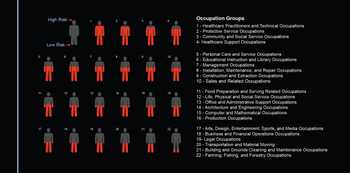How can we understand the job-associated risk of Covid-19 transmission? Which professional communities face the greatest risk of Covid-19 and which are the most naturally protected? How do workplace factors affect the spread of the disease within American communities and how can we understand that impact, now a year into the pandemic?
Occupations vary in the risk of exposure. Healthcare professionals, for example, live with increased risk because of treating the sick and the close quarters required by their work.
The Occupational Information Network (O*Net) database analyzes the activities associated with all occupations. Pinkerton Data Scientists combed through the many occupational descriptors, selecting work traits that increase an employee’s potential Covid-19 exposure. This granular view of work tasks and environments enabled us to construct a detailed index of Covid-19 risk. Combining data from the Bureau of Labor Statistics, we quantify the risks of each occupation and American workforces at-large.
Local level interventions have had varying impacts on the spread of the disease and accompanying economic and societal consequences. Remote work has changed the face of many industries, but just over a quarter of Americans are able to work from home. The majority of commerce involves in-person services or physical presence.
Many professions deemed essential workers have never ceased commuting to work throughout shutdowns, while other industries furloughed or laid off employees, resulting in record unemployment. Returning to work has meant increased Covid-19 risk in the absence of careful measures.
Viewing the occupational Covid-19 transmission risk of workers, we see the heightened risk of service workers and customer-facing occupations. This speaks to the primacy of America’s service economy, and the ongoing elevated risk faced by workers in this sector of the economy. In fact, the five most populous jobs in America are all exposed to above average Covid-19 transmission risk, including:
1. Retail Salespersons
2. Fast Food and Counter Workers
3. Cashiers
4. Registered Nurses
5. Office Clerks
Pinkerton data scientists then applied occupational risk indices to the geographic distribution of occupations, characterizing risk across metropolitan statistical areas, highlighting which cities experience elevated workforce transmission risk.
Viewing the elevated risk of service positions, in tandem with their importance to such a large fraction of America’s labor force offers insight into the ongoing risk of Covid-19 and it’s complex relationship to the American economy.
